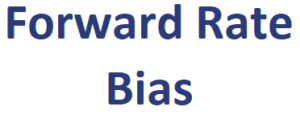Forward Rate Bias
Trading the forward rate bias, also known as a carry trade, refers to borrowing in the lower interest rate currency and investing the proceeds in a higher interest rate currency.
On this page, we discuss the issues that are important to have a good understanding of the the carry trade. In particular, we discuss the covered interest rate parity, the uncovered interest rate parity, and how a violation of the latter makes the carry trade profitable.
Carry trade fundamentals
There are three things we need to know to understand the carry trade:
- The covered interest rate parity (CIRP) holds by arbitrage and establishes that the difference between the spot and the forward exchange rate equals the difference in the periodic interest rates of the two currencies
- The currency with the higher interest rate will trade at a forward discount
- The currency with the lower interest rate will trade at a forward premium
- The carry trade is based on a violation of uncovered interest rate parity (UCIRP). UCIRP is an international relationship that asserts that the forward exchange rate calculated by CIRP is an unbiased estimate of the spot exchange rate that will exist in the future. If this would be true, then:
-
- The currency with the higher exchange rate should decrease in value by the amount of the initial interest rate differential
- The currency with the lower exchange rate should increase in value by the amount of the initial interest rate differential.If this would be true, then the carry trade would earn a zero return.
-
- Because the carry trade exploits a violation of interest rate parity, it can be referred to as trading the forward rate bias.
Trading the forward rate bias in practice
In practice, we find that higher interest rate currencies depreciate less than predicted by interest rate parity or appreciate. A small percentage of the tme, however, the higher interest rate currency depreciates substantially more than predicted by interest rate parity.
Implementing the carry trade
The carry trade is implemented by borrowing in the lower interest rate currencies of developed economies (funding currencies) and investing in the higher interest rate currencies of emerging economies (investing currencies).
Summary
We discussed the forward rate bias that makes carry trades profitable.

